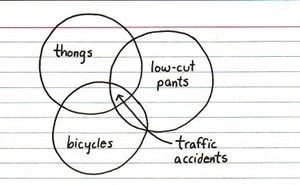One site that I like to read in large batches is Inexed. Like Engrish, it builds up and becomes funnier in larger chunks. I think this one is funny enough to share but, if it's not, go read more of them, then come back.

 Some people celebrate Christmas because they believe that it is the night that Jesus was born 2000+ years ago. Some people celebrate Christmas because it's what their family has always done.
Some people celebrate Christmas because they believe that it is the night that Jesus was born 2000+ years ago. Some people celebrate Christmas because it's what their family has always done.
Some people celebrate Winter Solstice because it is a holy day with that marks the return of the sun. Some people celebrate Winter Solstice because it is not Christmas.
I celebrate Christmas because I have the time off from work and it's an opportunity to spend time with people I don't often see. I celebrate on Christmas Eve with my step-mother's family and enjoy the company and relaxation. I celebrate on Christmas Day with my mother-in-law's family and enjoy the shared interests and, often, politics.
I celebrate Winter Solstice because it is the beginning of the deepest part of a Minnesota winter. I have had opportunities to move to warmer climates, but I like Minnesota. I like the cold; I like bundling up and taking on the weather. Sure, I look like I'm exploring Antarctica on my way into work in the morning, but that's something I would do if I had the resources. It bugs me a little when people complain about the cold yet continue to live in Minnesota; If you can't stand the cold, get out of the freezer.
On the other hand. I'm looking forward to biking again this spring.
 On Friday, December 19, The Crystal Method were joined by Jack Trash, Nathan Vox and Leon J for a night of live DJ'd music at Epic nightclub in Minneapolis presented by Sound In Motion.
On Friday, December 19, The Crystal Method were joined by Jack Trash, Nathan Vox and Leon J for a night of live DJ'd music at Epic nightclub in Minneapolis presented by Sound In Motion.
My first impression of the club was disorganization. The front door was unlocked and nobody was there to keep people from wandering in until they got up by the box office, some of the employees showing up before the doors officially opened were unaware of this and weren't sure how to get in. This is a big contrast to a venue like First Avenue where they lock the doors and have someone right inside to let the staff through.
 After a short wait in Minnesota weather, we walked in and started wandering the club looking for spots to shoot from. I have to say that, from a photographer's point of view, this isn't the best club to be at. Especially without stage access and especially for their DJ set configuration. The DJs were blocked by a box in front of the decks and two speakers on either side of them. The best view in the house was from a private box, which had a darned good view, but blocked the stage for the rest of us. Luckily, I'm used to odd locations and worked quickly to find the best spots to hang. And it took security a couple hours to figure out I'd been standing on couches and ask me to get off. A camera can only get you so far.
After a short wait in Minnesota weather, we walked in and started wandering the club looking for spots to shoot from. I have to say that, from a photographer's point of view, this isn't the best club to be at. Especially without stage access and especially for their DJ set configuration. The DJs were blocked by a box in front of the decks and two speakers on either side of them. The best view in the house was from a private box, which had a darned good view, but blocked the stage for the rest of us. Luckily, I'm used to odd locations and worked quickly to find the best spots to hang. And it took security a couple hours to figure out I'd been standing on couches and ask me to get off. A camera can only get you so far.
 My second impression of the club was that I had completely forgotten what the nightclub scene was like. It's probably been since I was 21 that I went to one of the local meet-markets. There was more prime flesh on display than I had seen in a long time and by the end of the night, all of it was thoroughly marinated. At least one guy reminded me of getting drunk in GTA IV. Clearly his whole world was spinning out of control.
My second impression of the club was that I had completely forgotten what the nightclub scene was like. It's probably been since I was 21 that I went to one of the local meet-markets. There was more prime flesh on display than I had seen in a long time and by the end of the night, all of it was thoroughly marinated. At least one guy reminded me of getting drunk in GTA IV. Clearly his whole world was spinning out of control.
The first set was Leon J who, and I'm going to show my ignorance here, I presume is a local DJ along with Jack Trash and Nathan Vox. He had a great stage presence and really opened up the crowd as they came in. The transitions through the other DJs and into The Crystal Method were seamless enough that I didn't even notice when Kirkland started spinning except that the energy in the place started to increase rapidly and the beats became more familiar to me. Those two are probably not entirely related since I talked to some folks in line who were there to see Jack Trash.
 Jordan and Kirkland served up dance tracks until 2:00, slipping in samples and beats from their albums that made the crowd go crazy when they realized their alcohol addled brains were taking in something familiar. Scott Kirkland is clearly the more outgoing of the duo. When Ken Jordan was spinning, Kirkland was often standing up on the podium and playing with the crowd, singing with the samples and taking pictures of and for the audience. When the Go-go dancers were in that spot, Kirland would dance behind them or play with Jordan's head, basically keeping the stage energy high and connecting with the crowd.
Jordan and Kirkland served up dance tracks until 2:00, slipping in samples and beats from their albums that made the crowd go crazy when they realized their alcohol addled brains were taking in something familiar. Scott Kirkland is clearly the more outgoing of the duo. When Ken Jordan was spinning, Kirkland was often standing up on the podium and playing with the crowd, singing with the samples and taking pictures of and for the audience. When the Go-go dancers were in that spot, Kirland would dance behind them or play with Jordan's head, basically keeping the stage energy high and connecting with the crowd.
It looks like the last time The Crystal Method was in Minneapolis was 2006. I'm hoping they don't wait another two years to come back, and I'll certainly be keeping my eyes open for more.
-- More Photos -- Crowd Photos

Everywhere I turn, people are talking about Chanukah, Christmas and even Kwanzaa rather than the return of the all-powerful life-giver The Sun. Christmas is particularly guilty of stealing light from our holiday celebrations.
The US government chose to recognize Christmas as a national holiday 1870 and I see this as the beginning of the political war on Winter Solstice. Since then, there's only been more and more downplay of the real reason for the season.
We must find a way to stop the war on Winter Solstice and take the holiday back from these heathens. Luckily, we have several iconic figures on our side. The Krampus, AKA Sinterklaas, has been biding his time in the guise of Santa Claus and it shouldn't take much to convince him to join our cause. Jack Frost has always been with us, causing Christmas shoppers to break presents and bones on the ice.
If we can get enough Christians to drink themselves into oblivion in the name of Jesus, I think we can take over, so go out there, distract them with a Jul Log and spike some Egg Nog!
When I hear about the auto industry bail-out requests my gut instinct is "you made your bed..." Then I think about the retirees who will lose their pensions because their employer was too shortsighted to realize that people wouldn't keep buying SUVs forever. And I think about the employees who will lose their jobs Because auto executives took the penny-wise route, staying the course and letting the Japanese manufacturers make the cars "nobody will buy."
There has to be a way to make sure those people are taken care of but the executives reap the consequences of their actions.
 David Hobby over at strobist.com has brought up an interesting and controversial subject: working for free. Go and read it, I'll wait....Yeah, I know it's long, skim it if you have too. I'm pretty patient though, so take your time...
David Hobby over at strobist.com has brought up an interesting and controversial subject: working for free. Go and read it, I'll wait....Yeah, I know it's long, skim it if you have too. I'm pretty patient though, so take your time...
See, that was worth it, right. So now, you're thinking things like this:
"Why would I do work that someone else, including myself, would charge for? I'd essentially be taking money out of their pockets. I could become known as the guy who works for free, which is never good, and if I mention it to professionals in the same field, they'll scoff, try to convince me otherwise, and probably never speak to me again."
But the idea does have it's merits within reason.
David gives several good reasons to work for free and I think they're all valid. I think a little clarification is needed as he doesn't go into the basic economics of the situation.
If, as David suggests, you are the initiator of a project and if your primary goal is creating something for your portfolio and if this project requires outside talent to be completed, then you are in the position of needing to hire that talent. Trading work for work is what economists call the "barter system" and it has been in place since the oldest profession got its start.
Just be careful about what you do for free. As David says, don't give a potential customer a free lunch. I would add that if there's any question make it clear that you normally charge for this and, unless there's another mutually beneficial situation, you would charge them in the future just as you would expect them to charge you if you needed their services.
Provided you stick to the rules, you're unlikely to be in the position of "Hey, what's the deal? Last time you did this for free!"
Edit: Like The Strobist, I'm seeing this from a photographic point of view, if you work in a field where you don't need anyone else's help, your economic mileage may vary.
 Remember way back in 2007 when we found out that Walter Reed Army Medical Center was in disrepair? That was pretty appalling wasn't it? I remember being mad at my government for not taking care of the troops and mad at the workers who waited so long to say anything.
Remember way back in 2007 when we found out that Walter Reed Army Medical Center was in disrepair? That was pretty appalling wasn't it? I remember being mad at my government for not taking care of the troops and mad at the workers who waited so long to say anything.
It turns out there's a new reason to be mad at my government for not taking care of the troops. Back in March, in an effort to give special recognition to military personnell who were injured in combat rather than in other military duties, such as training, the armed services sub-committee narrowed the definition of "combat related" disabilities. The Pentagon has interpereted things a little differently.
Army Sgt. Lori Meshell shattered a hip and crushed her back and knees while diving for cover during a mortar attack in Iraq. She has undergone a hip replacement and knee reconstruction and needs at least three more surgeries. ... [T]he Pentagon ruled that [her] disabilities were not combat-related.
--LA Times
How, you might wonder does a mortar attack in Iraq not count as "combat related?" Well, that seems to be the fault of congress, but that's not the problem. In my opinion, and in the opinion of the vet I am IMing with right now, that's really not the point. An injury incurred while in the military, in a situation you wouldn't have been in if you were not in the military, should be taken care of by the military.
Go read the article, get pissed off, write your representatives, senators and president.
 The blog you're reading is running on a homebrew perl engine that I wrote for the purpose of allowing customers to edit content on their page without needing ssh access to the server. That's a little daunting for people if they just want to change a few lines of text. The code is a few hundred lines and has a configuration file that is independent from the executable code. There's also no database, just a series of flat files. It's pretty basic, but it has served me well.
The blog you're reading is running on a homebrew perl engine that I wrote for the purpose of allowing customers to edit content on their page without needing ssh access to the server. That's a little daunting for people if they just want to change a few lines of text. The code is a few hundred lines and has a configuration file that is independent from the executable code. There's also no database, just a series of flat files. It's pretty basic, but it has served me well.
After learning what I have of Java and AJAX, I'd like to make some improvements. At the moment, nobody can comment on my posts, so I rarely get feedback. I occasionally post links on facebook where people can comment, but that seems like a lot of separation of content to me. When looking at other blog and community sites, I've discovered some things about how comments are handled and, in my opinion, what works and what doesn't.
I don't like the forum layout except for getting questions answered. Even then, it seems a little clunky without a working knowledge of the forum's organization. It seems to me that forums aren't a streamlined mechanism for community building because of their rigid organizational structure. Tagging would be an improvement on this because the user is more likely to guess a single tag correctly than guess the category a post is placed in sometimes.
Blogger/blogspot has an extremely clunky comment system. Posting a comment requires going to a new screen where, by default, the context of the comment you are about to make is removed from that screen. It's a small annoyance to make an extra click to see the orriginal post, but an annoyance nonetheless. Even then, the interface feels cramped since it is limited in width and has two columns of information showing.
Science Blogs is getting there. When you click on the permalink for a post the orriginal post, all the comments and a form to enter your comment are all displayed in-line on the page. It almost forces you to pre-read or at least scan the comments before yours prior to making a new comment, which is good for a community that has a tendency to not read things before spouting off duplicate comments. Not that I'm saying that's what the commenters there do, just that I've seen it before. Particularly on the Gawker Media websites.
 Gizmodo and Gawker Media, are also getting there. They changed their commenting system a couple years ago to force users to log in, which I know annoyed some veterans of the site. This has given them the ability to store your preferences for following other commenters or bookmarking your favorite posts. Many of the Gawker sites will honor your login from another Gawker site, which is very good, but some of them don't for some reason. That forces you to either log in again or create a new account. While that's not bad when you consider that the sites are not all the same and will have different readership and a different commenter base, it's a little annoying for users who are fans of the Gawker network as a whole. This sticks out especially so when one site crosslinks to another Gawker site and I can't comment there.
Gizmodo and Gawker Media, are also getting there. They changed their commenting system a couple years ago to force users to log in, which I know annoyed some veterans of the site. This has given them the ability to store your preferences for following other commenters or bookmarking your favorite posts. Many of the Gawker sites will honor your login from another Gawker site, which is very good, but some of them don't for some reason. That forces you to either log in again or create a new account. While that's not bad when you consider that the sites are not all the same and will have different readership and a different commenter base, it's a little annoying for users who are fans of the Gawker network as a whole. This sticks out especially so when one site crosslinks to another Gawker site and I can't comment there.
Facebook has made leaps and bounds in the community department, but their AJAX implementations seem to be a little random at times. I can refresh my news feed and get a completely different set of items, there are some people I rarely see in my feed even though I can see that their status has been updated, and there seems to be some sort of persistence algorithm that removes items from my feed after facebook is bored with them even if I haven't seen them yet. They do have a good, if militant system of notifications that not only sends you an email when someone has commented on you or something you have commented on but also tells you on the webiste, just in case you aren't following your email. It can get a little confusing at times since the email contains all the same content you would see on the website (usually) and I have a tendency to think "haven't I seen this?"
Flickr, despite being primarily a photo-sharing site has what I think is the pinacle of comment management. The news feed on your home page shows every photograph you're associated in one handy place. This is a change from the format that I actually liked better which showed comments on your photographs on one page and comments made after your comments on other photographs on another page. This keeps users interested. I comment on Gizmodo and on Science Blogs occasionally, when I feel I have something to say, but I don't get any feedback there. Someone could comment in direct response to my comment and i wouldn't know. At Gizmodo, I can go to my profile page and get links to all the comments I've made but then I have to click on that link to see if anyone commented after me and then filter through all the comments after mine to see if any of them are related. At Science Blogs, I have to remember what I commented on and go digging through the posts to find my comment and see what other people had to say. With Flickr, I can go to my home page and see that 8 people have commented since I commented on a photo (shown in thumbnail form) and read the comments right there.
As a result of my frustrations and happinesses of commenting in online communities, I've come up with a wish-list for the new blog engine that I'm working on.
- Users should be allowed to log in to make a post, but not forced to if they wish to remain anonymous. (Blogger)
- Users who wish to get a commenting account can comment with a username and password, if I like what they have to say or at least think it's interesting, I grant them an account. (Gawker)
- Users can see the last several comments on posts that they have commented on by logging in and going to their homepage. (flickr)
- Other users can see what commenters have posted by clicking on a commenter's name. (Gawker)
I never remember when the Ig Nobel prizes are given. Every Thanksgiving Friday, Science Friday plays an audio version of the award ceremonies and every year, that is my reminder that I missed the actual event.

This year's prizes included a few that I need to look into a little more, I think. The Archaeology Prize, which I can't believe that I hadn't read about on science blogs, was for "The Role of Armadillos in the Movement of Archaeological Materials: An Experimental Approach." I have to wonder how much this has been an issue in archaeological digs in the past in order to suggest that an experimental study would be required.
The Economics Prize went to a paper published in the field of evolution. "Ovulatory Cycle Effects on Tip Earnings by Lap Dancers: Economic Evidence for Human Estrus?" discovers that Lap Dancers get higher tips when they're ovulating. I have to say "duh" to this one, though it's not something that would have actually occurred to me. Maybe some additional research is required.
And, since I work in a moderately large organization, I have a certain fondness for both the title and the content of "You Bastard: A Narrative Exploration of the Experience of Indignation within Organizations." The author of the paper, David Sims, gave a rousing example of the subject of his work which I would love to have an occasion to use.
Anyway, the rest of the prize info is at Improbable Research.
 We just got back from the grocery store. It seems that we weren't the only ones doing some early last-minute shopping for Thanksgiving. Some of the items on the list were limes (for this weekend's margaritas), garlic, cranberries, eggs, and frozen orange juice. While checking my eggs for cracks, a little black boy squeezed past me to retrieve his family's eggs from the cooler. Right behind him, his sister was telling him, "Don't get any of those nasty brown ones!"
We just got back from the grocery store. It seems that we weren't the only ones doing some early last-minute shopping for Thanksgiving. Some of the items on the list were limes (for this weekend's margaritas), garlic, cranberries, eggs, and frozen orange juice. While checking my eggs for cracks, a little black boy squeezed past me to retrieve his family's eggs from the cooler. Right behind him, his sister was telling him, "Don't get any of those nasty brown ones!"
I decided we probably had enough milk to get through Thursday and continued on to the frozen juice section....
Comics
AppleGeeks
The Awkward Yeti
Chainsawsuit [new!]
Ctrl+Alt+Del
Doghousediaries
Doonesbury
Formal Sweatpants
FoxTrot
Happle Tea [new!]
Hyperbole and a Half
Indexed
Joy of Tech
Kate or Die!
Lunarbaboon
Our Valued Customers
RealLife
Romantically Apocalyptic
Saturday Morning Breakfast Cereal
Scenes From A Multiverse [new!]
A Softer World
Sci-ence
Sinfest
Three Panel Soul
Wondermark
XKCD
Blogs
Almost Diamonds Antihero As I See It Black and WTF Caerwyn Farm and Spirits The Catty Life Domestic Sluttery Engrish For Goodness Sake Gizmodo Greg Laden Le Zèbre Bleu Lefse and Kimchee Lifehacker Light-test Linux in Exile Man Bytes Blog Photography is Not a Crime Post Secret Photoshop Disasters
Arts
New Pictures 8: Sarah Jones
Minneapolis Institue of Arts
04/18/2013—02/02/2014 - Free
31 Years: Gifts from Martin Weinstein
Minneapolis Institue of Arts
11/02/2013—08/31/2014 - Free
New Pictures 9: Rinko Kawauchi
Minneapolis Institue of Arts
02/20/2014—08/10/2014 - Free
Finland: Designed Environments
Minneapolis Institue of Arts
05/10/2014—08/17/2014 - Free
Music
Nick Cave and the Bad Seeds
at State Theatre
06/21/2014 \ Doors 8:00pm
Please wait while my tweets load